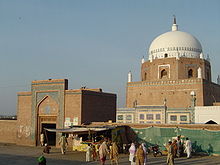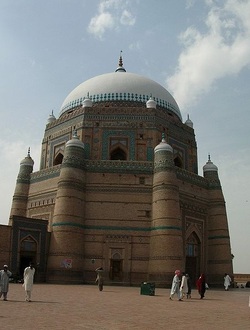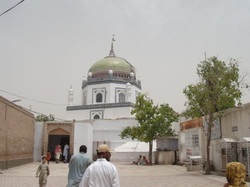Multan, The City Of Saints & Sufis
Hazrat Baha-ud-din Zakariya
Baha-ud-din Zakariya (Persian: بہاؤ الدین زکریا) was a Sufi of Suhrawardiyya order (tariqa). His full name was Al-Sheikh Al-Kabir Sheikh-ul-Islam Baha-ud-Din Abu Muhammad Zakaria Al-Qureshi Al-Asadi Al Hashmi. Sheikh Baha-ud-Din Zakariya known as Bahawal Haq was born at Kot Kehror, a town of the Layyah District near Multan, Punjab, Pakistan, around 1170. His grandfather Shah Kamaluddin Ali Shah Qureshi Al-Hashmi arrived in Multan from Mecca en route to Khwarezm where he stayed for a short while. In Tariqat he was the disciple of renowned Sufi master Shaikh Shahab al-Din Suhrawardi who awarded him Khilafat only after 17 days of stay at his Khanqah in Baghdad. For fifteen years he went from place to place to preach Islam and after his wanderings Bahawal Haq settled in Multan in 1222.

Hazrat Shah Rukn-e-Alam

Sheikh Rukn-ud-Din Abul Fath (1251-1335) commonly known by the title Rukn-e-Alam (pillar of the world) was among the eminent Sufi saints from Multan, Pakistan.
The Shaikh was the son of Pir Sadar-Al-Din Arif born at Multan on Friday, the 9th of Ramadan 649 Hijri (26 November 1251). He was the grandson and successor of Shaikh Baha-Ud-Din Zakariya.
Shaikh Rukn-e-Alam (Rukn-al-Din) died on Friday, the 7th of Jumada al-awwal 735 Hijri (3 January 1335). He was buried in the mausoleum of his grandfather, according to his own will. After sometime, however, his coffin was transferred to the present mausoleum.
The saint is still revered today and his tomb is the focus of the pilgrimage of over 100,000 pilgrims from all over South Asia who visit and commemorate his memory
The Shaikh was the son of Pir Sadar-Al-Din Arif born at Multan on Friday, the 9th of Ramadan 649 Hijri (26 November 1251). He was the grandson and successor of Shaikh Baha-Ud-Din Zakariya.
Shaikh Rukn-e-Alam (Rukn-al-Din) died on Friday, the 7th of Jumada al-awwal 735 Hijri (3 January 1335). He was buried in the mausoleum of his grandfather, according to his own will. After sometime, however, his coffin was transferred to the present mausoleum.
The saint is still revered today and his tomb is the focus of the pilgrimage of over 100,000 pilgrims from all over South Asia who visit and commemorate his memory
Hazrat Shah Shams Tabraiz

The mausoleum of Shams-ud-Din, commonly known as Shah Shams Tabrez, is located about half a mile to the east of the Fort site, on the high bank of the old bed of the River Ravi near Aam-Khas Garden. He was a descendant of Imam Jaffer and was born in 1165. He died in 1276 and the shrine was built by his grandson in 1330. The tomb is square, 30 feet (9.1 m) in height surmounted by a hemispherical dome. It is decorated with ornamental glazed tiles.
Hazrat Shah Gardez
Within the city of Multan Pakistan there is a shrine of Hazrat Muhammad Shah Yusaf Gardezi commonly known as Shah Gardez just inside the Bohar Gate. It is a rectangular domeless building decorated with glazed tiles, a work of considerable beauty. He came to Multan in 1088 and revitalized the then-dead city. Shah Yousaf Gardez converted many people to Islam and performed numerous miracles which can be found in history books. His descendants are known as Gardezis and are one of the few old noble families in the country.
Hazrat Musa Pak Shaheed
The Mausoleum of Syed Musa Pak Shaheed is inside the Pak Gate. Shaikh Abul Hassab Musa Pak Shaheed was a descendant of Abdul Qadir Jillani and was born in Uch. The Shrine of Musa Pak Shaheed is also frequented by a large number of Pashtuns from all parts of Pakistan
Hazrat Hafiz Muhammad Jamal Multani
The Mausoleum is situated near Aam Khas garden outside Daulat Gate, Multan. The tomb has been built within a wall resembling a fortification. The tomb lies on a platform of marble and is surrounded by an area paved with marble and black slate. On the North and West side there is an arched corridor which looks like a tunnel. On the south side there is an extensive congregational hall, whose timber roof is embellished with decorative work.
Hazrat Hafiz Muhammad Jamal was born in Multan about 1747 AD (1160 AH). His father’s name was Hafiz Muhammad Yusuf, that of his grand father Hafiz Abdul Rashid. He belonged to Awan tribe. He memorized the Holy Qur’an when he was still very young. He also studied religious and philosophical sciences. In the student days he used to excel and no one could oppose him in debates. As he advanced in years he felt attracted towards mystical meditation. He found a perfect guide and became disciple of Qibla-e-Aalam Hazrat Nur Muhammad Maharvi, a prominent sufi saint of Chishti order.
Hafiz Muhammad Jamal also learnt and mastered martial arts. Not merely an expert archer himself, he also used to instruct and train the soldiers. He was a unique sufi saint who was an eminent scholar, poet and a warrior as well. He used to fight and lead soldiers of Nawab Muzaffar Khan, ruler of Multan, against forces of Ranjeet Singh who attacked the city many times yet could not capture the fort and city during life time of Hafiz Jamal.
The most reliable source of life history of Hafiz Muhammad Jamal is the book ‘Jamalia” written by Maulvi Abdul Aziz Parharvi. As described in the book, Hafiz Muhammad Jamal was radiantly handsome, his teeth were unstrung pearls, his nose marvelously comely, his eyebrows thin, his chin pointed and his beard was extremely graceful. He used to walk at such a pace that young men were unable to keep up with him.
He had a ring, upon which were engraved the words “Allahu jamilun wa yohibbul jamal’ (God is beautiful and loves beauty). His discourse used to be most sweet and agreeable. In his life there was no contradiction between preaching and practice. History testifies that very many Hindus also benefited from his teachings and he never acted in a discriminatory way towards them. It is undoubtedly true that after the great Bahauddin Zakariyya Multani it was the Suhrawardi order which flourished in the region. Hafiz Jamal was the first saint to give currency to the Chishti order of sufism in Multan. He also established a very important centre of learning.
Hafiz Jamal died at the age of 66 on 5 Jamadi ul Sani 1226 ( 7th May, 1811). A chronogram for the date of his death was derived by his beloved pupil Munshi Ghulam Hassan from these words of Holy Qur’an: “innl muttaqin fi jannat”. Two other chronograms in Persian verses are also inscribed over the eastern gate of the tomb. He married twice and one of his wife was from Laang family. He had a considerable number of spiritual successors such as Khwaja Khuda Bakhsh of Khairpur Tamiwali.
Hafiz Jamal was an excellent poet in Arabic, Persian and Siraiki. His “Seeharfi” is a poem in Siraiki which comprises 29 stanzas of four rhyming lines each, the fourth containing the poet’s name ‘Jamal’. In this Hafiz Jamal uses the spinning wheel and its appurtenances as symbols of deeds and character. Copy of this ‘Seeharfi’ is available in the Punjab University Library. It was also once published in Agra, India. Very many accounts of Hafiz Jamal and his sayings were composed, many of which exist in the earlier books. The best known are i) ‘Fazail Raziyya’, ii) ‘Jamalia’ , iii) ‘Gulzar-e-Jamlia’ written in 1325/1907, and iv) ‘Anwar-e-Jamlia’. Now many more books have been written.
Ahsan Ejaz
Computer System Engineer
SANZ
Hazrat Hafiz Muhammad Jamal was born in Multan about 1747 AD (1160 AH). His father’s name was Hafiz Muhammad Yusuf, that of his grand father Hafiz Abdul Rashid. He belonged to Awan tribe. He memorized the Holy Qur’an when he was still very young. He also studied religious and philosophical sciences. In the student days he used to excel and no one could oppose him in debates. As he advanced in years he felt attracted towards mystical meditation. He found a perfect guide and became disciple of Qibla-e-Aalam Hazrat Nur Muhammad Maharvi, a prominent sufi saint of Chishti order.
Hafiz Muhammad Jamal also learnt and mastered martial arts. Not merely an expert archer himself, he also used to instruct and train the soldiers. He was a unique sufi saint who was an eminent scholar, poet and a warrior as well. He used to fight and lead soldiers of Nawab Muzaffar Khan, ruler of Multan, against forces of Ranjeet Singh who attacked the city many times yet could not capture the fort and city during life time of Hafiz Jamal.
The most reliable source of life history of Hafiz Muhammad Jamal is the book ‘Jamalia” written by Maulvi Abdul Aziz Parharvi. As described in the book, Hafiz Muhammad Jamal was radiantly handsome, his teeth were unstrung pearls, his nose marvelously comely, his eyebrows thin, his chin pointed and his beard was extremely graceful. He used to walk at such a pace that young men were unable to keep up with him.
He had a ring, upon which were engraved the words “Allahu jamilun wa yohibbul jamal’ (God is beautiful and loves beauty). His discourse used to be most sweet and agreeable. In his life there was no contradiction between preaching and practice. History testifies that very many Hindus also benefited from his teachings and he never acted in a discriminatory way towards them. It is undoubtedly true that after the great Bahauddin Zakariyya Multani it was the Suhrawardi order which flourished in the region. Hafiz Jamal was the first saint to give currency to the Chishti order of sufism in Multan. He also established a very important centre of learning.
Hafiz Jamal died at the age of 66 on 5 Jamadi ul Sani 1226 ( 7th May, 1811). A chronogram for the date of his death was derived by his beloved pupil Munshi Ghulam Hassan from these words of Holy Qur’an: “innl muttaqin fi jannat”. Two other chronograms in Persian verses are also inscribed over the eastern gate of the tomb. He married twice and one of his wife was from Laang family. He had a considerable number of spiritual successors such as Khwaja Khuda Bakhsh of Khairpur Tamiwali.
Hafiz Jamal was an excellent poet in Arabic, Persian and Siraiki. His “Seeharfi” is a poem in Siraiki which comprises 29 stanzas of four rhyming lines each, the fourth containing the poet’s name ‘Jamal’. In this Hafiz Jamal uses the spinning wheel and its appurtenances as symbols of deeds and character. Copy of this ‘Seeharfi’ is available in the Punjab University Library. It was also once published in Agra, India. Very many accounts of Hafiz Jamal and his sayings were composed, many of which exist in the earlier books. The best known are i) ‘Fazail Raziyya’, ii) ‘Jamalia’ , iii) ‘Gulzar-e-Jamlia’ written in 1325/1907, and iv) ‘Anwar-e-Jamlia’. Now many more books have been written.
Ahsan Ejaz
Computer System Engineer
SANZ
